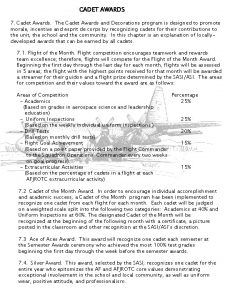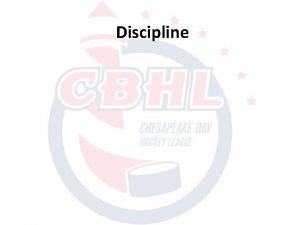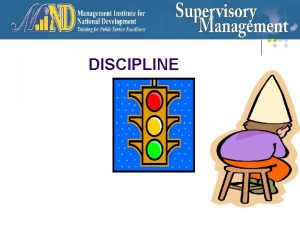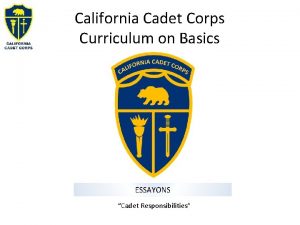CADET DISCIPLINE 2 Cadet Discipline The nature of








- Slides: 8

CADET DISCIPLINE 2. Cadet Discipline. The nature of the JROTC mission, as well as its high visibility within the school and community, requires its members to adhere to higher standards than normally found among the student population. 2. 1. Authority, Self-Discipline and Integrity. 2. 1. 1. All students signing up in the JROTC program must understand they have volunteered to accept the military rank structure used within the program. Therefore, all cadets will abide by the authority associated with rank and position within the unit. All cadets are expected to follow the directions of senior-ranking cadets. However, senior-ranking cadets WILL NOT abuse this authority; cadets with discipline or authority issues will be referred to the SASI/ASI. Hazing is not permitted in the JROTC program. Hazing is defined as harassment by abusive or embarrassing treatment. If at any time, a cadet feels they are being hazed or bullied, it needs to be immediately reported to the SASI/ASI. 2. 1. 2. Self-Discipline. Self-discipline is one of the principle concepts in the military and within the JROTC program. It allows each cadet to accept the use of authority mentioned in paragraph 2. 1. 1. Self-discipline is required by each cadet when he/she follows orders, shows proper courtesies, uses the proper form of addressing others, wears the uniform properly and performs directed duties. 2. 1. 3. Integrity is a firm adherence to a set of shared moral values; it is the cornerstone of the JROTC program. Integrity is knowing and doing what is right and what is expected of you, even if no one is watching you. It is that sense of ‘right’ versus ‘wrong’ and is the foundation of trust and respect within any team or unit. A cadet’s integrity allows others to know you will do the best you can, and that your word can be trusted. Cadets who fail to learn or display integrity cannot expect to advance into leadership roles. 2. 2. Classroom Rules. In order to remain in the JROTC program, cadets must, as a minimum: 1) conform to all customs, courtesies, training requirements and professional responsibilities, 2) maintain a class academic average of C(70%) an overall GPA of D (60%) and/or recommendation by the SASI/ASI to progress to the next JROTC course semester. 2. 2. 1. Cadet participation is the key to esprit de corps and is vital to your learning and enjoyment during the school year. To make the most of your education, cadets are expected to attend class on a daily basis, come to class prepared for the day’s work, and contact the SASI/ASI to arrange for known forthcoming absences or to make-up unexpected absences in accordance to school policy.

2. 2. 2. All cadets are encouraged to take an active interest in and participate in as many AFJROTC extracurricular activities as possible. Activity and participation points will be awarded to those who are involved for eligibility of various AFJROTC ribbons. It is mandatory for all cadets to participate in at least three AFJROTC extracurricular activities; participation in three events will be a grade of 100, participation in two event only will be a grade of 60, participation in one event will be a grade of 50 and lack of participation in any extracurricular activity will be a of 0. The JROTC website lists all extracurricular activities, as well as listening to classroom announcements on upcoming events. At any time you may check with the SASI/ASI on upcoming events and your grade. 2. 2. 3. All cadets will abide by the NCHS classroom rules, to include the following: - No gum chewing, eating food, or drinking in the classroom. - Do not put feet on chairs or desks nor sit on desks. Keep all four legs of the chairs on the floor. - No sleeping (stand up in the back of the room if needed). - Do not enter SASI/ASI office or supply rooms unless accompanied by the SASI/ASI or senior cadet officer. - Sit in assigned seats unless given permission to move by the SASI, ASI or flight commander. - Stand at ‘attention’ during Pledge of Allegiance and roll call. - Respect your fellow cadets. - Keep your desks and classroom area clean. Book bags will be stored neatly under your desk, not in the aisle or on your desk. - By exception, bathroom breaks may be taken with the approval of the SASI/ASI. Use good judgment on when to ask to use the bathroom. - Remain in the classroom until dismissed by the SASI/ASI or the flight commander. - Cell phones must be turned off, unless the instructor states they may be used for classroom activities. If a cell phone ‘goes off’ in class or is visible when not approved for use, it will be reported as a minor incident report (MIR). 2. 2. 4. Consequences for failing to follow classroom rules and procedures include, but are not limited to: warnings, MIRs, parental contact, control room, after-school detention, and/or referrals to school administrators for additional consequences. Always remember, your conduct not only represents your character, but also represents the JROTC program and Northwest Cabarrus High School.

2. 3. Merit and Demerit System. 2. 3. 1. Merit System. The purpose of the Merit System is to encourage cadet ownership to their unit, as well as a means to recognize the cadets within the corp. Cadets who demonstrate their duties in an exceptional manner, demonstrate a superior attitude, or other positive reasons my be recognized by a merit. The following process will be used for the issuing of merits. 2. 3. 1. 1. Anyone in a cadet’s chain of command may issue a merit to a cadet. Also, any officer may issue a merit to any cadet and the Cadet First Sergeant may issue a merit to any enlisted cadet. 2. 3. 1. 2. Merits will be issued using the Merit Report, Figure 1. Copies of the Merit Report are filed in the staff room. The cadet issuing the Merit Report will ensure it is signed and reviewed by the cadet receiving the merit. Once the Merit Report is completed by both cadets, the cadet issuing the report will ensure it is turned in to the Cadet Group Commander or Cadet Deputy Group Commander. Once the merit has been reviewed by the SASI/ASI, the ASI will ensure the Cadet First Sergeant receives the Merit Report for filing in the cadet’s personnel file as well as annotation for upcoming promotion boards. 2. 3. 2. Demerit System. The purpose of the Demerit System is to continue to encourage cadet ownership to their unit, as well as a means to identify and respond appropriately to negative behavior. Prior to issuing a demerit, cadets are encouraged to talk with the cadet demonstrating the negative behavior first, before issuing a written demerit. Demerits should be issued for cadets who repeatedly demonstrate a negative behavior, disregard classroom rules, fail to perform their duties or responsibilities assigned to them, or other negative reasons that detract from the overall performance of the unit. The process to issue a demerit is the same as the merit system, paragraphs 2. 3. 1. 1 – 2. 3. 1. 2. See Figures 2 and 2 A, Demerit Report. 2. 4. Discipline Boards. Discipline boards may be conducted to review a cadet’s negative performance for consideration for demotion and/or removal from an assigned position on the unit manning document. Any action by a cadet that reflects discredit upon the JROTC program, the school and/or the community or whose behavior negatively impacts unit performance can be a reason for a discipline board. The following process will be used for a discipline board.

2. 4. 1. The Cadet Group Commander will request a discipline board. The SASI will have final approval to conduct a discipline board. 2. 4. 2. Once approved by the SASI to conduct a discipline board, the Cadet Group Commander will ensure date, time and panel members to be on the board are coordinated. At least 3 other officers must be on the board, all of which are in the chain of command for the cadet meeting the board. 2. 4. 3. Once the date, time and panel members are determined, the Cadet Group Commander will notify, in writing, the cadet meeting the board. If the cadet meeting the board is unable to meet the board on the designated date, every opportunity should be made to reschedule the board date. If problems continue with scheduling, the SASI will make the final determination. 2. 4. 4. For the discipline board, the Cadet Group Commander will be the Board President. The SASI or ASI must be present during the board process. The cadet meeting the board will report in. The Board President will brief the cadet the reason for the discipline board, then allow the cadet to explain/defend himself or herself. The panel members may ask questions at any time to get clarification of the cadet’s responses. Once the panel members feel they have enough information to make a , recommendation, the cadet meeting the board will be excused. The Board President will ensure a final recommendation is made regarding the cadet’s discipline action and pass this decision to the SASI or ASI in attendance. The SASI will have final approval for any recommendation made by the discipline board. 2. 4. 5. Once the SASI has made his decision, the Cadet Group Commander will meet, in person, with the cadet who met the board notifying him/her of the results of the board, in writing. The SASI or ASI will also be in attendance at this meeting. Additionally, the results of the discipline board will be filed in the cadet’s personnel file by the Cadet Group Commander. 2. 5. Textbooks and Color Guard/Drill Equipment. AFJROTC Headquarters has authorized NC-20066 to requisition, receive, store, issue and account for Air Force equipment issued to NCHS for JROTC use. Any equipment, to include uniforms, books, ropes, berets, etc. , issued to a cadet is the responsibility of that cadet. Hand-receipts or other documentation will be generated by the JROTC instructors for any Air Force or school equipment issued. Each cadet in receipt of any JROTC or school item is the sole responsible person and may be charged the cost of the item if it is lost, stolen or damaged.

MERIT REPORT NC-20066 Cadet Name: _______________________ Date: _________ Behavior Noted: (Be specific, with facts only, including place and time) Printed Name of Reporting Individual: _____________________ Signature of Reporting Individual: _______________________ Cadet Signature: _____________________ Date: __________ Cadet Comments: Cadet Group Commander (Circle one) Approve / Disapprove Cadet Group Commander Signature: ______________ Date: _________ SASI / ASI (Circle one) Approve / Disapprove SASI/ASI Signature: ____________________ Date: __________ Additional Instructions: - Anyone in a cadet’s chain of command may issue a merit to a cadet. Also, any cadet officer may issue a merit to any cadet. The Cadet First Sergeant may issue a merit to any enlisted cadet. -Once the report is written up, the issuing cadet will notify the receiving cadet, requesting the cadet’s signature and response. -Once the receiving cadet signs the report, the issuing cadet will give it to the Cadet Group Commander or Cadet Deputy Group Commander within one school day. -The Cadet Group Commander/Deputy Group Commander will review and recommend approval or disapproval and will then provide the Merit Report to the SASI/ASI within two school days for final concurrence. -The SASI/ASI will review and recommend approval or disapproval and will then provide the Merit Report to the Cadet Group Commander within two school days for filing and annotation in the Promotion Board file. Figure 1. Merit Report

DEMERIT REPORT NC-20066 Cadet Name: _______________________ Date: _________ Behavior Noted: (Be specific, with facts only, including place and time) Printed Name of Reporting Individual: _____________________ Signature of Reporting Individual: _______________________ Cadet Signature: _____________________ Date: __________ Cadet Comments: Cadet Group Commander (Circle one) Approve / Disapprove Cadet Group Commander Signature: ______________ Date: _________ Cadet Comments: I, (circle one) DO DO NOT wish to appeal the Cadet Group Commander’s decision to the SASI/ASI. If appealing, the reason for my appeal is SASI / ASI (Circle one) Approve / Disapprove SASI/ASI Signature: ____________________ Date: __________ Figure 2. Demerit Report

Additional Instructions: - Anyone in a cadet’s chain of command may issue a demerit to a cadet. Also, any cadet officer may issue a merit to any cadet. The Cadet First Sergeant may issue a merit to any enlisted cadet. -Once the report is written up, the issuing cadet will notify the receiving cadet, requesting the cadet’s signature and response. -Once the receiving cadet signs the report, the issuing cadet will give it to the Cadet Group Commander or Cadet Deputy Group Commander within one school day. -The Cadet Group Commander/Deputy Group Commander will review and recommend approval or disapproval and will then notify the cadet of the demerit action. If the demerit is approved, the cadet will sign acknowledging whether he/she wishes to appeal the decision or not. The Cadet Group Commander will then provide the Demerit Report to the SASI/ASI within three school days for final concurrence. -The SASI/ASI will review and recommend approval or disapproval. If a cadet wishes to appeal the Cadet Group Commander’s decision, the SASI/ASI will ensure personal contact/discussion with the cadet prior to making a decision regarding the demerit report. The ASI will then provide the completed Demerit Report to the Cadet Group Commander within two school days for filing and annotation in the Promotion Board file. Attachment 2 A. Demerit Report

2. 6 Disenrollment. The goal of the AFJROTC program is to build citizens of character. Program requirements include: taking AFJROTC academic courses, participation in the cadet corps activities, properly wearing the prescribed uniform each required uniform day, meeting and maintaining Air Force grooming standards and maintaining acceptable disciplinary standards. For those cadets who are consistently deficient in one or more areas, demonstrate a negative pattern of behavior, and/or are disruptive to the overall corps operations, steps will be taken for disenrollment. 2. 6. 1. The SASI is allowed to disenroll an AFJROTC cadet at any time during the academic year with proper cause. Prior to disenrollment, the following actions will be taken. 2. 6. 1. 1. Documentation of the negative behaviors and/or incidents will be maintained by the SASI and ASI which will include corrective counseling, giving the cadet an opportunity to correct the negative behavior. 2. 6. 1. 2. Instructors will coordinate with the cadet’s parents/guardians, school counselors and administrators to resolve the issues. 2. 6. 1. 3 If efforts by instructors, parents, counselors and/or administrators are unsuccessful, and the cadet continues to choose to not comply with program requirements, then the SASI will be allowed to remove the cadet from the AFJROTC program. A maximum of three weeks is sufficient to complete this entire administrative process. 2. 6. 2. Cadets may be disenrolled from AFJROTC based on any other conductrelated reason deemed appropriate by the SASI or the Principal.















